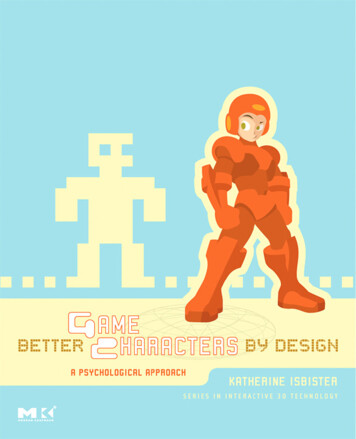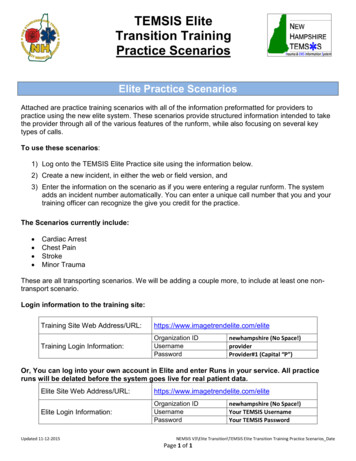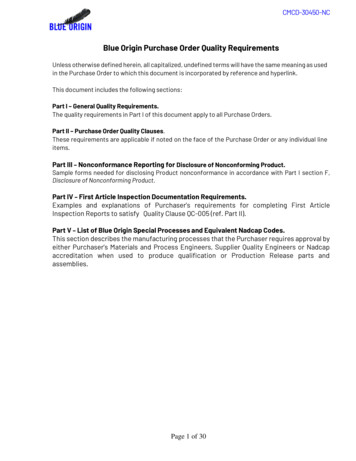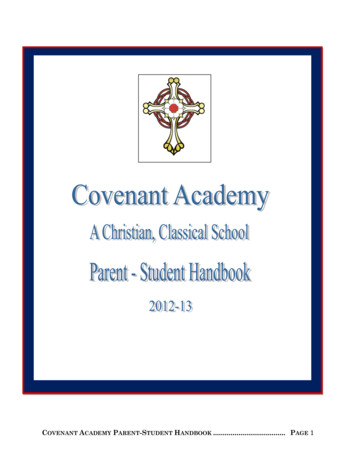
Transcription
This page intentionally left blank.
shambhala library
Start Where You Area guide tocompassionate livingPema ChödrönShambhalaBoston2004
Frontispiece: Gampo Abbey, Cape Breton, Nova Scotia.Photograph by Liza MatthewsS hambhala P ublications, I nc.Horticultural Hall300 Massachusetts AvenueBoston, Massachusetts 02115www.shambhala.com 1994 by Pema ChödrönTranslation of The Root Text of the Seven Points of Training the Mind 1981, 1986 by Chögyam Trungpa; revised translation 1993 byDiana J. Mukpo and the Nālandā Translation Committee. TheSādhana of Māhamudrā 1968, 1976 by Chögyam Trungpa.All rights reserved. No part of this book may be reproduced inany form or by any means, electronic or mechanical, includingphotocopying, recording, or by any information storage andretrieval system, without permission in writing from the publisher.The author’s proceeds from this book will be donated to Gampo Abbey,Pleasant Bay, Nova Scotia, Canada b0e 2p0.9 8 7 6 5 4 3 2printed in chinaThis edition is printed on acid-free paper that meets theAmerican National Standards Institute z39.48 Standard.Distributed in the United States by Random House, Inc.,and in Canada by Random House of Canada LtdThe Library of Congress catalogues the previous edition of this title as follows:Chödrön, Pema.Start where you are: a guide to compassionate living / Pema Chödrön.—1st ed.p. cm.Includes bibliographical references.eisbn 978-0-8348-2116-3isbn 978-0-87773-880-0 (alk. paper)isbn 978-1-57062-839-9 (pbk.)isbn 978-1-59030-142-5 (Shambhala Library)1. Spiritual life—Buddhism. 2. Buddhism—China—Tibet—Doctrines.I. Title.bq7805.c49 1994 93-39135294.3’444—dc20 cip
To my mother, Virginia, andmy granddaughter, Alexandria
This page intentionally left blank.
contentsPrefaceixAcknowledgmentsxiii1. No Escape, No Problem12. No Big Deal123. Pulling Out the Rug204. Let the World Speak for Itself275. Poison as Medicine366. Start Where You Are447. Bringing All That We Meet to the Path608. Drive All Blames into One699. Be Grateful to Everyone7710. Cutting the Solidity of Thoughts8711. Overcoming Resistance9712. Empty Boat10913. Teachings for Life and Death11514. Loving-Kindness and Compassion12415. Lighten Up13016. Abandon Any Hope of Fruition13617. Compassionate Action144vii
Contentsviii18. Taking Responsibility forYour Own Actions15619. Communication from the Heart16520. The Big Squeeze17521. High-Stakes Practice19022. Train Wholeheartedly201Appendix: The Root Text of the SevenPoints of Training the Mind207Bibliography213Resources215Index of Slogans219
p r e fa c eThis book is about awakening the heart. If youhave ever wondered how to awaken your genuine compassionate heart, this book will serve asa guide.In our era, when so many people are seeking helpto relate to their own feelings of woundedness andat the same time wanting to help relieve the suffering they see around them, the ancient teachingspresented here are especially encouraging and tothe point. When we find that we are closing down toourselves and to others, here is instruction on howto open. When we find that we are holding back,here is instruction on how to give. That which is unwanted and rejected in ourselves and in others canbe seen and felt with honesty and compassion. Thisis teaching on how to be there for others withoutwithdrawing.I first encountered these teachings in The GreatPath of Awakening by the nineteenth-century Tibetanteacher Jamgön Kongtrül the Great. Called the lojong teachings, they include a very supportive meditation practice called tonglen and the practice ofworking with the seven points of mind training,ix
xPrefacewhich comes from an old Tibetan text called TheRoot Text of the Seven Points of Training the Mind, byChekawa Yeshe Dorje. (See appendix.)Lojong means “mind training.” The lojong teachings are organized around seven points that containfifty-nine pithy slogans that remind us how to awakenour hearts.* Working with the slogans constitutes theheart of this book. These teachings belong to themahayana school of Buddhism, which emphasizescompassionate communication and compassionaterelationship with others. They also emphasize thatwe are not as solid as we think. In truth, there is enormous space in which to live our everyday lives. Theyhelp us see that the sense of a separate, isolated selfand a separate, isolated other is a painful misunderstanding that we could see through and let go.Tonglen means “taking in and sending out.” Thismeditation practice is designed to help ordinary people like ourselves connect with the openness andsoftness of our hearts. Instead of shielding and protecting our soft spot, with tonglen we could let ourselves feel what it is to be human. By so doing, wecould widen our circle of compassion. Through thisbook I hope others may find such encouragement.When I first read the lojong teachings I was struckby their unusual message that we can use our difficulties and problems to awaken our hearts. Rather*The slogans are also available as a set of cards that one could use asan aid in working with these teachings. See page 217 for information
Prefacexithan seeing the unwanted aspects of life as obstacles,Jamgön Kongtrül presented them as the raw materialnecessary for awakening genuine uncontrived compassion: we can start where we are. Whereas inKongtrül’s commentary the emphasis is primarily ontaking on the suffering of others, it is apparent that inthis present age it is necessary to also emphasize thatthe first step is to develop compassion for our ownwounds. This book stresses repeatedly that it is unconditional compassion for ourselves that leads naturally to unconditional compassion for others. If weare willing to stand fully in our own shoes and nevergive up on ourselves, then we will be able to put ourselves in the shoes of others and never give up onthem. True compassion does not come from wantingto help out those less fortunate than ourselves butfrom realizing our kinship with all beings.Later I heard these instructions presented in amore contemporary mode by my own teacher, Chögyam Trungpa, Rinpoche. (These have now beenpublished in the book Training the Mind and Cultivating Loving-Kindness.) Trungpa Rinpoche pointedout that he had first been given these teachings whenhe was quite young and that it was a great relief tohim to find that Buddhism could be so practical andso helpful in everyday life. He was inspired to findthat we could bring everything we encounter to thepath and use it to awaken our intelligence, our compassion, and our ability to take a fresh look.
xiiPrefaceIn the winters of 1992 and 1993, I led one-monthpractice periods, called dathuns, completely dedicated to these lojong teachings and to the meditationpractice of tonglen. Most important, those of us participating wanted to put these instructions into practice continually as the inevitable frustrations anddifficulties of daily life arose. We saw the dathun as achance to take the instructions to heart and applythem in all situations, especially those in which weusually prefer to blame or criticize or ignore. That is,we saw it as a chance to use the teachings to relate onthe spot with an open heart and an open mind to theaggression, the craving, and the denial that we find inourselves and in others.Even for those who are unfamiliar with meditation, the lojong teachings present the possibility of anentire change of attitude: we could relate compassionately with that which we prefer to push away, andwe could learn to give away and share that which wehold most dear.For those who feel prepared to practice sittingmeditation and tonglen meditation and to work withthe lojong slogans in an ongoing way, doing so may bethe beginning of learning what it really means to love.This is a method for allowing a lot of space, so thatpeople can relax and open. This is the path of unconditional compassionate living. It is designed especially for people who find themselves living in timesof darkness. May it be of benefit.
acknowledgmentsI would like to acknowledge the help of PatCousineau and Lynne Vande Bunte, who did most ofthe typing, and of Judith Anderson, Marilyn Hayes,Trime Lhamo, Lynne Vande Bunte, and HelenTashima, who did the transcribing. Also thanks toPam Gaines, who not only typed but also found people to help, and especially to Migme Chödrön, whodid the first edit of the original manuscript and was aconstant support to me during all the steps of preparing this book. Last but certainly not least, I wantto thank Emily Hilburn Sell of Shambhala Publications. I feel extremely fortunate that she once againagreed to transform the talks into their final form.xiii
This page intentionally left blank.
Start Where You Are
This page intentionally left blank.
1No Escape, No ProblemWe already have everything we need. Thereis no need for self-improvement. All thesetrips that we lay on ourselves—the heavy-duty fearing that we’re bad and hoping that we’re good, theidentities that we so dearly cling to, the rage, the jealousy and the addictions of all kinds—never touchour basic wealth. They are like clouds that temporarily block the sun. But all the time our warmth andbrilliance are right here. This is who we really are.We are one blink of an eye away from being fullyawake.Looking at ourselves this way is very different fromour usual habit. From this perspective we don’t needto change: you can feel as wretched as you like, andyou’re still a good candidate for enlightenment. Youcan feel like the world’s most hopeless basket case,but that feeling is your wealth, not something to bethrown out or improved upon. There’s a richness toall of the smelly stuff that we so dislike and so littledesire. The delightful things—what we love so dearlyabout ourselves, the places in which we feel somesense of pride or inspiration—these also are ourwealth.1
2No Escape, No ProblemWith the practices presented in this book, you canstart just where you are. If you’re feeling angry, poverty-stricken, or depressed, the practices describedhere were designed for you, because they will encourage you to use all the unwanted things in your lifeas the means for awakening compassion for yourselfand others. These practices show us how to acceptourselves, how to relate directly with suffering, howto stop running away from the painful aspects of ourlives. They show us how to work openheartedly withlife just as it is.When we hear about compassion, it naturallybrings up working with others, caring for others. Thereason we’re often not there for others—whether forour child or our mother or someone who is insultingus or someone who frightens us—is that we’re notthere for ourselves. There are whole parts of ourselves that are so unwanted that whenever they beginto come up we run away.Because we escape, we keep missing being righthere, being right on the dot. We keep missing themoment we’re in. Yet if we can experience the moment we’re in, we discover that it is unique, precious,and completely fresh. It never happens twice. Onecan appreciate and celebrate each moment—there’snothing more sacred. There’s nothing more vast orabsolute. In fact, there’s nothing more!Only to the degree that we’ve gotten to know ourpersonal pain, only to the degree that we’ve related
No Escape, No Problem3with pain at all, will we be fearless enough, braveenough, and enough of a warrior to be willing to feelthe pain of others. To that degree we will be able totake on the pain of others because we will have discovered that their pain and our own pain are not different.However, to do this, we need all the help we canget. It is my hope that this book will supply that help.The tools you will be given are three very supportivepractices:1. Basic sitting meditation (called shamathavipashyana meditation)2. The practice of taking in and sending out(called tonglen)3. The practice of working with slogans (calledthe seven points of mind training, or lojong)All these practices awaken our trust that the wisdom and compassion that we need are already withinus. They help us to know ourselves: our rough partsand our smooth parts, our passion, aggression, ignorance, and wisdom. The reason that people harmother people, the reason that the planet is pollutedand people and animals are not doing so well thesedays is that individuals don’t know or trust or lovethemselves enough. The technique of sitting calledshamatha-vipashyana (“tranquillity-insight”) is like agolden key that helps us to know ourselves.
4No Escape, No ProblemShamatha-Vipashyana MeditationIn shamatha-vipashyana meditation, we sit uprightwith legs crossed and eyes open, hands resting on ourthighs. Then we simply become aware of our breathas it goes out. It requires precision to be right therewith that breath. On the other hand, it’s extremely relaxed and extremely soft. Saying, “Be right there withthe breath as it goes out,” is the same thing as saying,“Be fully present.” Be right here with whatever isgoing on. Being aware of the breath as it goes out, wemay also be aware of other things going on—soundson the street, the light on the walls. These things maycapture our attention slightly, but they don’t need todraw us off. We can continue to sit right here, awareof the breath going out.But being with the breath is only part of thetechnique. These thoughts that run through ourminds continually are the other part. We sit here talking to ourselves. The instruction is that when yourealize you’ve been thinking, you label it “thinking.”When your mind wanders off, you say to yourself,“Thinking.” Whether your thoughts are violent orpassionate or full of ignorance and denial; whetheryour thoughts are worried or fearful, whether yourthoughts are spiritual thoughts, pleasing thoughts ofhow well you’re doing, comforting thoughts, upliftingthoughts, whatever they are, without judgment or
No Escape, No Problem5harshness simply label it all “thinking,” and do thatwith honesty and gentleness.The touch on the breath is light: only about 25 percent of the awareness is on the breath. You’re notgrasping or fixating on it. You’re opening, letting thebreath mix with the space of the room, letting yourbreath just go out into space. Then there’s somethinglike a pause, a gap until the next breath goes outagain. While you’re breathing in, there could be somesense of just opening and waiting. It is like pushingthe doorbell and waiting for someone to answer.Then you push the doorbell again and wait for someone to answer. Then probably your mind wanders offand you realize you’re thinking again—at this point,use the labeling technique.It’s important to be faithful to the technique. Ifyou find that your labeling has a harsh, negative toneto it, as if you were saying, “Dammit!,” that you’re giving yourself a hard time, say it again and lighten up.It’s not like trying to down the thoughts as if theywere clay pigeons. Instead, be gentle. Use the labeling part of the technique as an opportunity to developsoftness and compassion for yourself. Anything thatcomes up is okay in the arena of meditation. Thepoint is, you can see it honestly and make friendswith it.Although it is embarrassing and painful, it is veryhealing to stop hiding from yourself. It is healing toknow all the ways that you’re sneaky, all tæhe ways
6No Escape, No Problemthat you hide out, all the ways that you shut down,deny, close off, criticize people, all your weird littleways. You can know all that with some sense ofhumor and kindness. By knowing yourself, you’recoming to know humanness altogether. We are all upagainst these things. We are all in this together. Sowhen you realize that you’re talking to yourself, labelit “thinking” and notice your tone of voice. Let it becompassionate and gentle and humorous. Thenyou’ll be changing old stuck patterns that are sharedby the whole human race. Compassion for others begins with kindness to ourselves.*Lojong PracticeThe heart of this book is the lojong practice andteachings. The lojong practice (or mind training) hastwo elements: the practice, which is tonglen meditation, and the teaching, which comes in the form ofslogans.The basic notion of lojong is that we can makefriends with what we reject, what we see as “bad” inourselves and in other people. At the same time, wecould learn to be generous with what we cherish,what we see as “good.” If we begin to live in this*If you’ve never tried sitting meditation before, you may wish toseek the guidance of a qualified meditation instructor. See the listof meditation centers at the back of the book for help in finding aninstructor.
No Escape, No Problem7way, something in us that may have been buried fora long time begins to ripen. Traditionally this “something” is called bodhichitta, or awakened heart. It’ssomething that we already have but usually have notyet discovered.It’s as if we were poor, homeless, hungry, and cold,and although we didn’t know it, right under theground where we always slept was a pot of gold. Thatgold is like bodhichitta. Our confusion and miserycome from not knowing that the gold is right hereand from always looking for it somewhere else. Whenwe talk about joy, enlightenment, waking up, orawakening bodhichitta, all that means is that weknow the gold is right here, and we realize that it’sbeen here all along.The basic message of the lojong teachings is that ifit’s painful, you can learn to hold your seat and movecloser to that pain. Reverse the usual pattern, whichis to split, to escape. Go against the grain and holdyour seat. Lojong introduces a different attitude toward unwanted stuff: if it’s painful, you become willing not just to endure it but also to let it awaken yourheart and soften you. You learn to embrace it.If an experience is delightful or pleasant, usuallywe want to grab it and make it last. We’re afraid thatit will end. We’re not inclined to share it. The lojongteachings encourage us, if we enjoy what we are experiencing, to think of other people and wish forthem to feel that. Share the wealth. Be generous with
8No Escape, No Problemyour joy. Give away what you most want. Be generouswith your insights and delights. Instead of fearingthat they’re going to slip away and holding on tothem, share them.Whether it’s pain or pleasure, through lojong practice we come to have a sense of letting our experiencebe as it is without trying to manipulate it, push itaway, or grasp it. The pleasurable aspects of beinghuman as well as the painful ones become the key toawakening bodhichitta.There is a saying that is the underlying principleof tonglen and slogan practice: “Gain and victoryto others, loss and defeat to myself.” The Tibetanword for pride or arrogance, which is nga-gyal, isliterally in English “me-victorious.” Me first. Ego.That kind of “me-victorious” attitude is the cause ofall suffering.In essence what this little saying is getting at isthat words like victory and defeat are completely interwoven with how we protect ourselves, how weguard our hearts. Our sense of victory just means thatwe guarded our heart enough so that nothing gotthrough, and we think we won the war. The armoraround our soft spot—our wounded heart—is nowmore fortified, and our world is smaller. Maybe nothing is getting in to scare us for one whole week, butour courage is weakening, and our sense of caringabout others is getting completely obscured. Did wereally win the war?
No Escape, No Problem9On the other hand, our sense of being defeatedmeans that something got in. Something touched oursoft spot. This vulnerability that we’ve kept armoredfor ages—something touched it. Maybe all thattouched it was a butterfly, but we have never beentouched there before. It was so tender. Because wehave never felt that before, we now go out and buypadlocks and armor and guns so that we will neverfeel it again. We go for anything—seven pairs ofboots that fit inside each other so we don’t have tofeel the ground, twelve masks so that no one can seeour real face, nineteen sets of armor so that nothingcan touch our skin, let alone our heart.These words defeat and victory are so tied up withhow we stay imprisoned. The real confusion iscaused by not knowing that we have limitless wealth,and the confusion deepens each time we buy intothis win/lose logic: if you touch me, that is defeat,and if I manage to armor myself and not be touched,that’s victory.Realizing our wealth would end our bewildermentand confusion. But the only way to do that is to letthings fall apart. And that’s the very thing that wedread the most—the ultimate defeat. Yet lettingthings fall apart would actually let fresh air into thisold, stale basement of a heart that we’ve got.Saying “Loss and defeat to myself” doesn’t mean tobecome a masochist: “Kick my head in, torture me,and dear God, may I never be happy.” What it means
10No Escape, No Problemis that you can open your heart and your mind andknow what defeat feels like.You feel too short, you have indigestion, you’re toofat and too stupid. You say to yourself, “Nobody lovesme, I’m always left out. I have no teeth, my hair’s getting gray, I have blotchy skin, my nose runs.” That allcomes under the category of defeat, the defeat of ego.We’re always not wanting to be who we are. However,we can never connect with our fundamental wealthas long as we are buying into this advertisement hypethat we have to be someone else, that we have tosmell different or have to look different.On the other hand, when you say, “Victory to others,” instead of wanting to keep it for yourself, there’sthe sense of sharing the whole delightful aspect ofyour life. You did lose some weight. You do like theway you look in the mirror. You suddenly feel like youhave a nice voice, or someone falls in love with you oryou fall in love with someone else. Or the seasonschange and it touches your heart, or you begin to notice the snow in Vermont or the way the trees move inthe wind. With anything that you want, you begin todevelop the attitude of wanting to share it instead ofbeing stingy with it or fearful around it.Perhaps the slogans will challenge you. They saythings like “Don’t be jealous,” and you think, “Howdid they know?” Or “Be grateful to everyone”; youwonder how to do that or why to bother. Some slogans, such as “Always meditate on whatever provokes
No Escape, No Problem11resentment,” exhort you to go beyond commonsense. These slogans are not always the sort of thingthat you would want to hear, let alone find inspiring,but if we work with them, they will become like ourbreath, our eyesight, our first thought. They will become like the smells we smell and the sound we hear.We can let them permeate our whole being. That’sthe point. These slogans aren’t theoretical or abstract. They are about exactly who we are and what ishappening to us. They are completely relevant tohow we experience things, how we relate with whatever occurs in our lives. They are about how to relatewith pain and fear and pleasure and joy, and howthose things can transform us fully and completely.When we work with the slogans, ordinary life becomes the path of awakening.
2No Big DealThe practices we’ll be doing help us developtrust in our awakened heart, our bodhichitta. Ifwe could finally grasp how rich we are, our sense ofheavy burden would diminish, and our sense of curiosity would increase.Bodhichitta has three qualities: (1) it is soft andgentle, which is compassion; (2) at the same time, itis clear and sharp, which is called prajna; and (3) itis open. This last quality of bodhichitta is calledshunyata and is also known as emptiness. Emptinesssounds cold. However, bodhichitta isn’t cold at all,because there’s a heart quality—the warmth of compassion—that pervades the space and the clarity.Compassion and openness and clarity are all onething, and this one thing is called bodhichitta.Bodhichitta is our heart—our wounded, softenedheart. Now, if you look for that soft heart that weguard so carefully—if you decide that you’re goingto do a scientific exploration under the microscopeand try to find that heart—you won’t find it. You canlook, but all you’ll find is some kind of tenderness.There isn’t anything that you can cut out and putunder the microscope. There isn’t anything that you12
No Big Deal13can dissect or grasp. The more you look, the moreyou find just a feeling of tenderness tinged withsome kind of sadness.This sadness is not about somebody mistreatingus. This is inherent sadness, unconditioned sadness.It has part of our birthright, a family heirloom. It’sbeen called the genuine heart of sadness.Sometimes we emphasize the compassionate aspect of our genuine heart, and this is called the relative part of bodhichitta. Sometimes we emphasizethe open, unfindable aspect of our heart, and this iscalled the absolute, this genuine heart that is justwaiting to be discovered.The first slogan of the seven points of mind training is “First, train in the preliminaries.” The preliminaries are the basic meditation practice—beneficial, supportive, warm-hearted, brilliant shamathavipashyana practice. When we say, “First, train in thepreliminaries,” it’s not as if we first do shamathavipashyana practice and then graduate to somethingmore advanced. Shamatha-vipashyana practice is notonly the earth that we stand on, it’s also the air webreathe and the heart that beats inside us. Shamatha-vipashyana practice is the essence of all otherpractices as well. So when we say, “First, train in thepreliminaries,” it simply means that without thisgood base there’s nothing to build on. Without it wecouldn’t understand tonglen practice—which I’ll de-
14No Big Dealscribe later—and we wouldn’t have any insight intoour mind, into either our craziness or our wisdom.Next, there are five slogans that emphasize theopenness of bodhichitta, the absolute quality of bodhichitta. These point to the fact that, although we areusually very caught up with the solidness and seriousness of life, we could begin to stop making such abig deal and connect with the spacious and joyful aspect of our being.The first of the absolute slogans is “Regard all dharmas as dreams.” More simply, regard everything as adream. Life is a dream. Death is also a dream, for thatmatter; waking is a dream and sleeping is a dream.Another way to put this is, “Every situation is a passing memory.”We went for a walk this morning, but now it is amemory. Every situation is a passing memory. As welive our lives, there is a lot of repetition—so manymornings greeted, so many meals eaten, so manydrives to work and drives home, so many times spentwith our friends and family, again and again, over andover. All of these situations bring up irritation, lust,anger, sadness, all kinds of things about the peoplewith whom we work or live or stand in line or fighttraffic. So much will happen in the same way overand over again. It’s all an excellent opportunity toconnect with this sense of each situation being like amemory.
No Big Deal15Just a few moments ago, you were standing in thehall, and now it is a memory. But then it was so real.Now I’m talking, and what I have just said has alreadypassed.It is said that with these slogans that are pointingto absolute truth—openness—one should not say,“Oh yes, I know,” but that one should just allow amental gap to open, and wonder, “Could it be? Am Idreaming this?” Pinch yourself. Dreams are just asconvincing as waking reality. You could begin to contemplate the fact that perhaps things are not as solidor as reliable as they seem.Sometimes we just have this experience automatically; it happens to us naturally. I read recently aboutsomeone who went hiking in the high mountains andwas alone in the wilderness at a very high altitude. Ifany of you have been at high altitudes, you know thelight there is different. There’s something more blue,more luminous about it. Things seem lighter and notso dense as in the middle of a big city, particularly ifyou stay there for some time alone. You’re sometimesnot sure if you’re awake or asleep. This man wrotethat he began to feel as if he were cooking his mealsin a dream and that when he would go for a walk, hewas walking toward mountains that were made out ofair. He felt that the letter he was writing was made ofair, that his hand was a phantom pen writing thesephantom words, and that he was going to send it offto a phantom receiver. Sometimes we, too, have that
16No Big Dealkind of experience, even at sea level. It actuallymakes our world feel so much bigger.Without going into this much more, I’d like tobring it down to our shamatha practice. The key is,it’s no big deal. We could all just lighten up. Regardall dharmas as dreams. With our minds we make abig deal out of ourselves, out of our pain, and out ofour problems.If someone instructed you to catch the beginning,middle, and end of every thought, you’d find that theydon’t seem to have a beginning, middle, and end.They definitely are there. You’re talking to yourself,you’re creating your whole identity, your whole world,your whole sense of problem, your whole sense ofcontentment, with this continual stream of thought.But if you really try to find thoughts, they’re alwayschanging. As the slogan says, each situation and eveneach word and thought and emotion is passing memory. It’s like trying to see when water turns into steam.You can never find that precise moment. You knowthere’s water, because you can drink it and make itinto soup and wash in it, and you know there’s steam,but you can’t see precisely when one changes into theother. Everything is like that.Have you ever been caught in the heavy-duty scenario of feeling defeated and hurt, and then somehow, for no particular reason, you just drop it? It justgoes, and you wonder why you made “much adoabout nothing.” What was that all about? It also hap-
No Big Deal17pens when you fall in love with somebody; you’re s
Chödrön, Pema. Start where you are: a guide to compassionate living/Pema Chödrön.— 1st ed. p. cm. . Start Where You Are 44 7. Bringing All That We Meet to the Path 60 8. Drive All Blames into One 69 9. Be Grateful to Everyone 77 10. Cutting the Solidity of Thoughts 87 11. Overcoming Resistance 97











